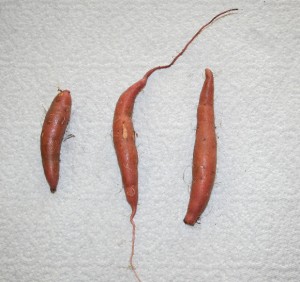I follow a gardening column by local writer Edwina Covington in our newspaper, the Farmville Herald.
Edwina wrote a few weeks ago about harvesting sweet potatoes, and how this was the right time of year to get that ‘tater crop in. I was in a bit of a panic since we were leaving; would my sweet potatoes be all right? I had to leave them. No time to harvest them. This is my first year and I don’t know what I’m doing, frankly. I’m a “trial and error” type of gardener; I plant things, fuss with them, let nature takes its course, and then figure out what worked and what didn’t. Since this is my first year growing sweet potatoes, I’ve been trying to learn from the locals what to do and when to do it. The vines look great, but what’s happening under the soil?
Mr. Hoffman, the retired chemistry teacher who lived next door to me when I was growing up and who ‘farmed’ on his little lot and a half in our suburban/urban area taught me to use test patches in the vegetable garden. If you don’t know what you’re doing, or whether or not a vegetable will grow well, he’d say, try a little bit in a corner of the garden and see what happens. Well, I sowed two sweet potato plants in the beet and onion bed, and those were my test taters. The big 16 x 16 bed is overflowing with sweet potato vines (and weeds – I am growing a great crop of weeds), but I left those alone and dug up the remaining beets and the test sweet potatoes.
The picture here shows the babies. They are like ‘fingerling’ potatoes at this stage, about the length and width of the pointer finger on your hand. I’m guessing that the drought this year has slowed down their growth. I’m going to leave them alone at least until the end of October….if a frost is predicted, I may need to dig them up, but looking at them they need at least another month. And rain! It’s supposed to be rainy for the next several days. I just get the feeling from looking at them that they need abundant rainfall for that last big growth spurt.
Maybe they’ll be ready in time for Thanksgiving dinner in November?





